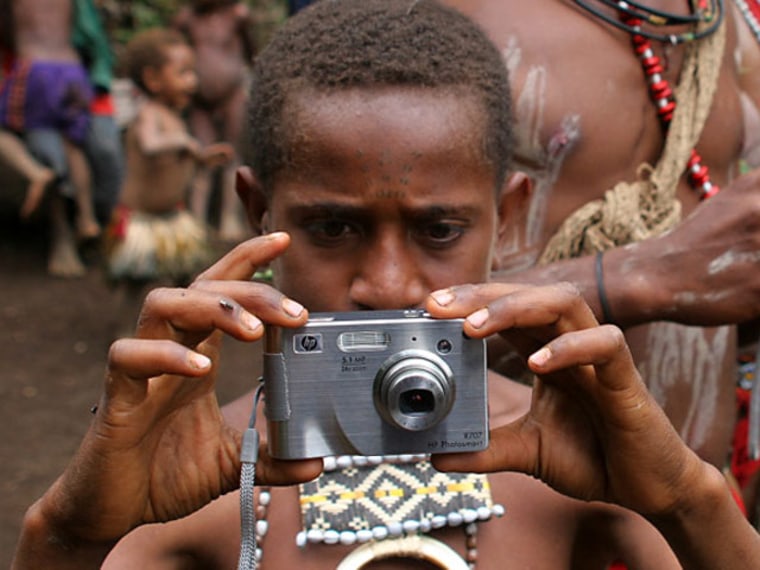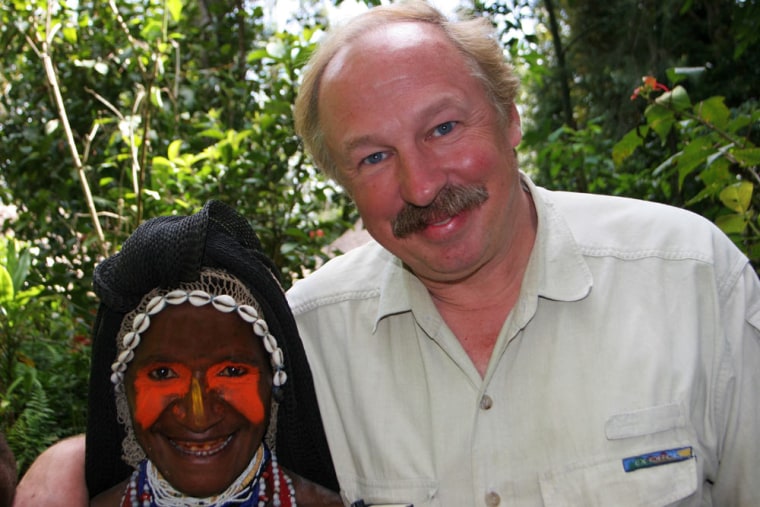Paul Poki is one of three headmen for 600-person Teka clan. There are no heredity chiefs here; rank is made upon merit – excellence with a bow and arrow proficiency at mediating disputes, the skill sets of a CEO. When we explain our concept of the Digital Village he grins: Why not use his family?
Well, not all his family. He has two wives and eight children and an unknown number of uncles, aunts and cousins scattered about this hanging valley. But he introduces us to his first wife, Mathar, who is 40, and missing an index finger which she cut off in spite during a dispute with her father. Also his uncle Hapo, who is somewhere in his 60s, and is most distinguished by the plastic serrated seal from a bottle of cooking oil that runs through his nose. Then his teenaged son James, 16 who has a sort of slacker slouch and a rusty key hanging from his neck; and finally Ope, who is just 7, and prone to popping forest flowers in his hair.
We gather in a common area of packed dirt, and Didrik passes out the HP Photosmarts to Paul’s family. Each rolls the silver box about in his hands as though examining a shiny shell. None has ever held a camera before. Didrik patiently shows how to use the digital cameras, placing the viewfinders in front of their wide eyes, framing for a shot, and demonstrating where to push to capture the image. Paul and James speak some English, and they translate to the others as Didrik explains: “It stops time… it’s like preserving a memory.”
First contact print
In the astonishing documentary “First Contact” Mick Leahy and his band of gold miners, upon entering the Highlands of New Guinea in the early 1930s, take out a gramophone and play it for their hosts, who grapple with the concept and the device in what looks to be a combination of wonder, awe and dread. The same looks flash through Paul’s family now as Didrik gently guides each one through the steps of composing and crafting an image – a piece of their lives is snared as though in a trap, and brought home to savor, like a lorikeet in a bamboo cage.
They each fumble around a bit with the process, placing fingers in front of the lens, moving the camera as the shutter is pushed, but after a short time they master the technique and begin firing away. Other members of the clan file out of the forest, and look over the shoulders of the Teka shooters.
Mathar, the mom, can’t suppress a grin through the thick canary-yellow paint that cakes her face like a gaudy mud pack, and nods her head in approval at every image she creates. This is a culture where women are disenfranchised to the extreme: they are not allowed in the men’s house, are not permitted to own property, and are relegated to tending pigs. But suddenly Mathar seems empowered, as though she were unexpectedly gifted new status, and she struts about with increasing confidence, pointing her camera in all directions.
Ope and Hapo, youngest and oldest, are more tentative and reflective. They take an image and then stare at it for a period, as though trying to absorb its meaning, before moving on to the next. James is intrigued with the various functions, and figures out how to use the video utility. And Paul, commanding in his toreador wig of human hair, arranges other clan members in a row and takes their portraits.
The Spirit Dance
Several of the men in the clan decide to perform a spirit dance, a traditional ensemble piece in which painted witch doctors chant and stomp about, shaking their black palm bows and arrows, in a hex to rid an ailing clan member of bad spirits. As they stamp about in the dirt to a somber drum beat, waving their russet-plumed headdresses as do displaying birds of paradise, Paul’s family takes photos off to the side. Only Mathar takes a Clintonesque move forward, closer to the constituency, and reaches her camera into the swirl of color. I look over her shoulder at the images she is concocting, and the headdresses seem so brilliant they look almost as if lit from within.

When the dance is done, each family member continues to photograph around the compound. When the spirit dancers line up for a group shot, Mathar moves behind them to author perhaps a more creative picture, something like the famous Babe Ruth shot taken from behind the plate. Then Mathar moves to the sidelines and begins to take photos of the various young boys in attendance. In this society mothers only raise their sons for the first five years, then they move to the men’s house, where there is little female interaction for the rest of their lives. This opportunity to re-capture her sons must resonate with her.
When each of the family has taken about 50 images, Didrik pulls out the HP portable printer, and one by one removes the memory card from the individual cameras. Didrik lets each photographer choose the images he or she likes from the monitor, from which he then makes glossy, full-color prints. Mathar’s favorite is one she took of her young son Ope, and after it is printed, she proudly holds it against her face, and asks that I take a photo of her with the picture of her son. This picture within a picture is even more popular, and Mathar and Ope both want copies, which they then clutch to their chests as they move about the crowd.
Family memories
James looks at the family photo and says he wants to take a picture of one of his grandmothers, who is old and enfeebled, so he can remember her when she passes. Yes, Didrik promises, he can. Paul overhears and comments, “This is good to keep the culture.”
Though missionaries and miners have been crawling around this valley for decades, the Huli have show scant interest in adopting outside ways. Yet at the end of the day when we ask the family about the digital experience, each comments that the photos they took make them happy, and they want to take more.

Mathar, I must confess, reminds me of my own mother, who had a very similar beatific smile whenever she took photos of her family. I left the coop and began to travel in my early 20s, yet whenever I would return she would always meet me at the airport gate, and snap away as I came down the ramp. She treasured those photos like gold, as millions of mothers before and since, and now Mathar is a part of that tribe.
As a last image of the day, Mathar asks that a picture be taken of the two of us together. As I write this my own mother is quite ill in a hospice, and somehow this image seems to connect us all together, and I print out three copies, one for Mathar, one for me, and one to take home for my own mother.
Great Escapes is exploring Papua New Guinea in search of the Digital Village, filing daily dispatches along the way. If you have a question or comment, mail us at greatescapes@msnbc.com.